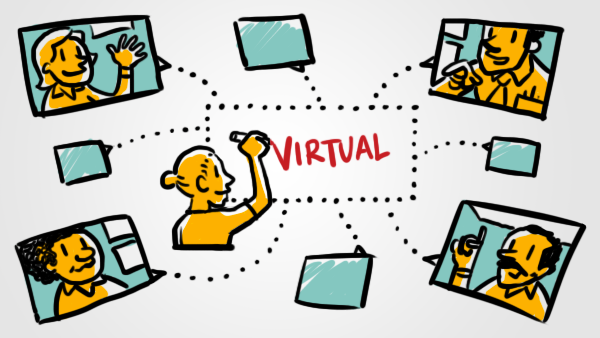We’ve all been on that conference call that stretches an hour (or hours) too long where it seems either one person drones on and on, or people jump over one another to speak, jostling to get their ideas heard. And then the next day, everyone’s notes seem to indicate different action items.
Modern video conferencing is a streamlined solution for helping people feel like they’re in the same room, but does it really move the needle as far as problem-solving or idea sharing?
One way to alleviate some of the more common pitfalls of the video conference call (as noted above) is to employ a virtual whiteboard.
This can be achieved in a couple of ways- not including rigging your laptop camera to awkwardly capture a tiny corner of the whiteboard on your conference room wall. There are several major players in the field of virtual whiteboard software that offer their own solutions to accomplish various goals depending on your business. Even Google has an impressive virtual whiteboard – with an equally impressive price tag.
But you don’t have to spring for software to gain the benefits of interactive whiteboarding; a good graphic facilitation company can also lead virtual whiteboarding sessions for you, thanks to swift artistic talent, cloud technology, and a good grip on the concept of visual idea-sharing.
What are the benefits of virtual whiteboard sessions in video conferencing?
Virtual whiteboards offer more effective collaboration
Having a single whiteboard to focus on, versus multiple faces and/or voices, gives your video conference a common purpose, and drives collaboration that is more directed, meaningful, and productive. A virtual whiteboard can be preloaded with an agenda, or quickly populated with pertinent questions and answers.
ProTip: The goal of the meeting should be “pinned” to the top of the whiteboard to stay visible throughout.
It’s a bonus if the person responsible for getting ideas and topics onto the whiteboard can also facilitate the conversation, but even if that’s not possible, you can leverage templates and even color-coding to ensure that everyone’s voice is heard.
Streamlined problem solving
By incorporating a virtual whiteboard, you’re introducing holistic organization and documentation to a meeting that otherwise would only be immortalized in individual notebooks or laptops. Ensure everyone is on the same page by stating your goal, documenting the steps to take to achieve that goal, and rather than getting caught up in tangential conversations, create a “parking lot” area where other topics can be jotted down to be addressed at a later time.
Creativity is encouraged
Slideshows or screen shares can be stale and ineffective. Picking up a pen, illustrating a conversation, or using visual notetaking is inclusive, interactive, and by default, it encourages creativity. It’s rewarding to see ideas drawn up in real-time, and the format is appealing to visual and audio learners alike.
Many interactive whiteboard programs will also allow meeting participants to share and edit their own files, meaning that when inspiration strikes, you can act instantly rather than wait for an email. And if you have a graphic facilitator or someone sketchnoting your meeting, you can build upon the inspiration of the images and quotes they choose to pull out and illustrate on the whiteboard.
Ideas and action items are captured
A collective agenda, agreed-upon action items, and every topic in between can be noted and stored on a virtual whiteboard. No more counting on one person’s interpretation of the meeting, depending on your own notes or arguing about which action items were actually declared at the meeting’s conclusion.
Not only can these things be prominently visible during the video conference, but they can also be sent out to all participants after the meeting, and even printed out as a supplement or poster if they are compelling to a wider audience or hold long-term significance. Also, anything erased from the whiteboard is effectively deleted, which limits confusion after the meeting or when sharing to others who weren’t in the meeting.
Improved engagement and retention
Even the snazziest sketches and the most pertinent action items will fade from memory eventually. Luckily simply by virtue of using a virtual whiteboard, this is less of a concern- brain science is on your side. Interactive visual cues and images can improve visual memory by strengthening visual cues in the brain. Adding relevant visuals to audio-only video conferencing results in a host of benefits- the brain processes visuals faster, retains ideas presented visually longer, and can even become more motivated by viewing images.
Some scientists believe that 65% of the population are visual learners. So why stick to audio-only meetings? Incorporating visual techniques into your video conferencing will likely be much appreciated- and lead to more effective collaboration and more productive meetings overall.

